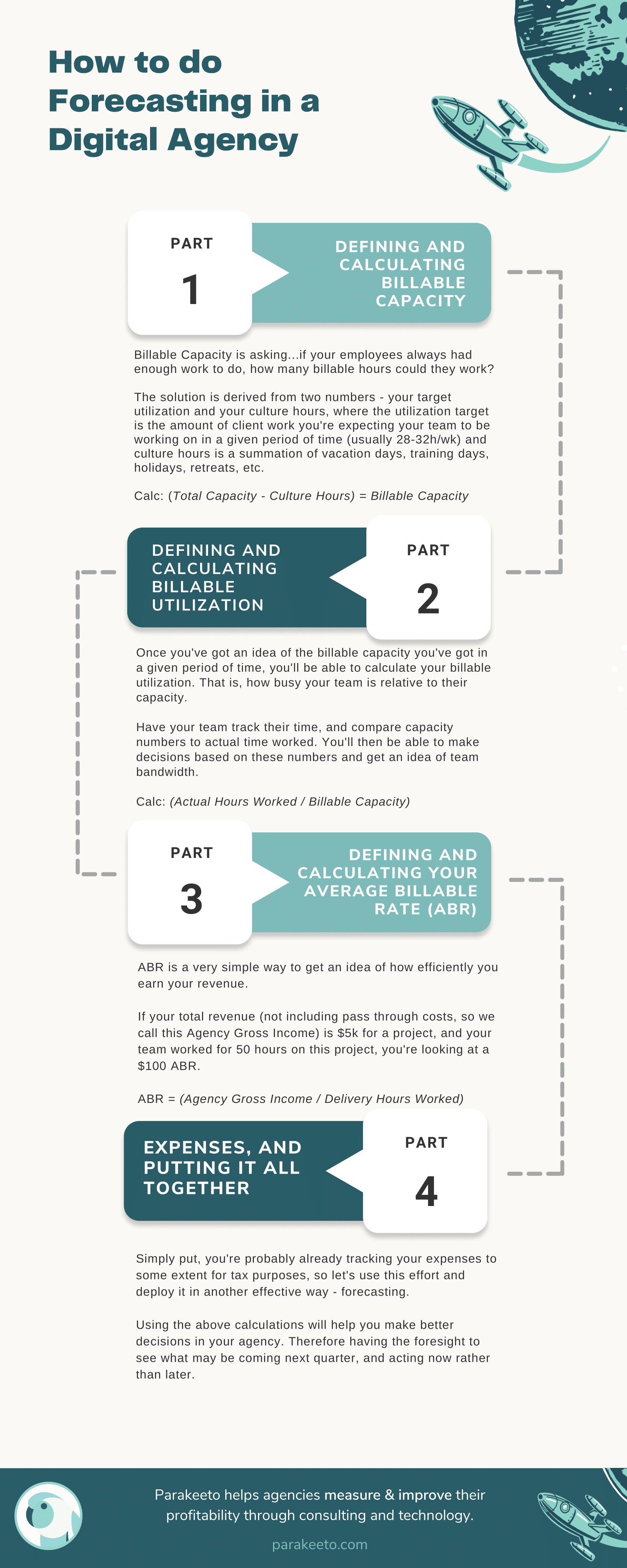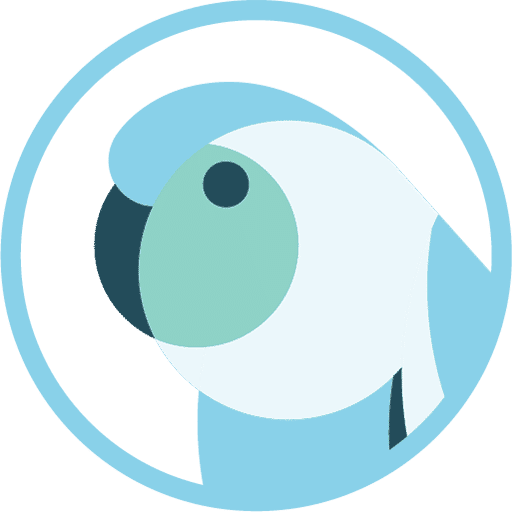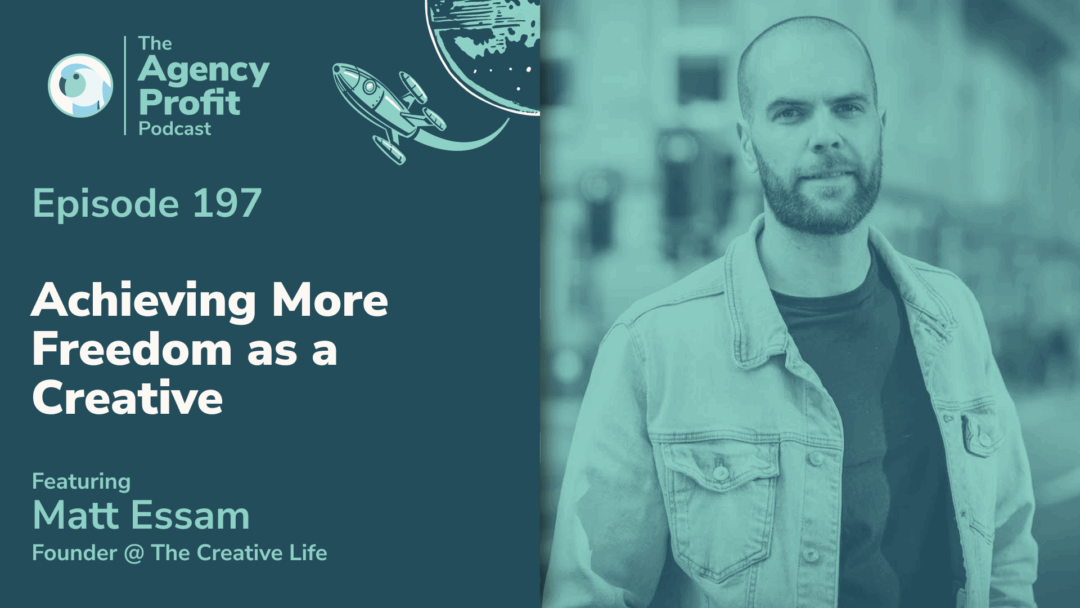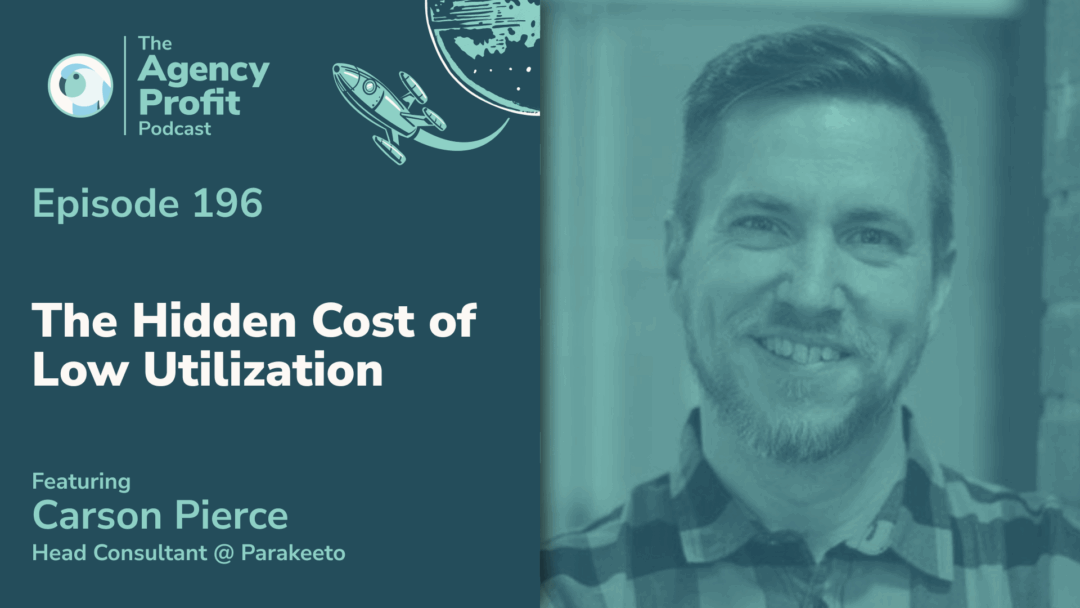Agency Forecasting is can be an elusive concept. As CEO of a company that works exclusively with Digital Agencies, I get to spend a lot of time hearing about the challenges our clients face. Forecasting finances and sales is one of the common challenges I see, especially for those in that very challenging 1.5-5 million / ARR phase (or 10-30 employee range). In fact, most agencies that get stuck at that size generally don’t break through until they figure this piece out.
When I ask agency owners questions like “What’s the maximum revenue you could earn this year?” – “What’s the difference between your Standard Billable Rate and your Average Billable Rate?” – “What’s the profit margin on your last 5 clients/projects” or even “When will you have the cash flow to hire your next employee?” and far too often, they’re stumped.
Maybe you’re in a similar spot. Maybe you don’t know how much cash you’ll have in your bank account in 6 months, or even the next 30 – 90 days. Maybe you can’t tell me what the best month to make a big purchase is, or when you’ll need to hire another employee (and have the cash to do it)
Maybe you find yourself lying awake some nights wondering what you’ll do if a big client decides to fire you, or if a really key employee finds another job. Maybe you’ve had a few too many close calls with payroll, barely making it or having to pull out a credit card to get everyone’s family fed. If you’re nodding your head, don’t worry, you’re definitely not alone.
Things like this are common, and they can have a huge impact on a smaller agency that’s trying to grow. I’ve seen this stuff stall growth for years, cost hardworking employees their jobs, and even shut agencies down altogether.
A Better Way
So, what If I told you there was an easy way to build a forecast that can be looked at as little as once a month and maintain a very high level of accuracy. What’s more, it can be used as a financial model to run scenarios against ahead of time.
Want to give your employees an extra week of vacation this year? You can plug that in and understand exactly what kind of an impact that will have on your agency’s finances.
Same thing with losing a big client, increasing your overhead, sponsoring a big event, doing another company retreat. Really, anything that could impact on your company’s Capacity, Utilization or Income/Expenses, you would be able to simulate in your forecast and see the impact.
Sounds cool right?
Well you’re in luck, because that’s exactly what I’m going to show you how to do in this blog post.
I Know What You’re Thinking…
Despite all this, when I start talking about agency forecasting, I’m often met with objections like:
“We can’t accurately predict our sales, or consistently hit budgets on our projects, so what’s the point of making a forecast? It will never be accurate anyway.”
Sound familiar?
The good news is, that’s complete BS.
There are 4 simple numbers that need to be tracked in order to generate an accurate forecast.
As long as those numbers are revised and updated on a semi-regular basis, the forecast can maintain a pretty good level of accuracy, and you can get visibility you need to make smart decisions and scale your agency sustainably.
The Equation
This equation pretty much sums up forecasting for a service-based business. All you have to do is pick a time period, get an accurate historical measurement for these metrics, and plug them in.
So, how do you figure out what each of these numbers is & should be?
Let’s get into it!
1. Billable Capacity
The first thing that needs to be clearly established for your forecast is the total billable capacity of your team; ie – in a perfect world, if your employees always had enough work to do, how many billable hours could they work?
Quick Note: This is independent of how you bill your clients. Regardless of if you bill flat fees, quote projects up front, bill hourly, have a recurring model, sell sprints, or all of the above, understanding the billable capacity of your team is FUNDAMENTAL to the economics of a service business. It has nothing to do with how you bill your clients, and everything to do with how you track things internally.
Anyway, back to capacity.
There are two main elements in capacity:
- Target Utilization
- Culture Hours
Let’s discuss these individually, then talk about how to put them together.
1. Target Utilization
Sometimes I refer to this as “gross utilization”, regardless, it basically answers the following question:
In a normal week, with no vacation, holidays, sick days or special team events – with a full workload – how many hours do you expect your full-time production employees to spend on client work?
For some agencies, that number might be 28 hours, for others, it might be 40.
For most agencies, it’s between 32-34 hours.
That means that on a normal day, an employee will spend a total of 6.5 – 7 hours on client work. The rest of the time, they might be checking email, in internal meetings, eating lunch, or working on internal projects.
If we consider a normal working week to be 40 hours, that means most agencies have somewhere between 80 – 85% as a utilization target on a week to week basis.
That number might vary based on role or seniority as well. For example, you may have a design lead who’s target is only 22 hours a week, because you expect them to spend some time coaching the team and doing more administrative/managerial stuff.
So the first step to figuring out capacity is having a clear expectation of what utilization targets look like for each member of the team, a simple spreadsheet is a good way to start figuring that out.
So that’s the target on a regular day, but what about the not-so-regular days (there are lots of those) how do you account for all that?
That’s where culture days come in to play.
2. Culture Days
The next important piece is to factor in your “Culture Days” or all the other stuff that’s going to eat away at your billable capacity over the year.
The number you’ll be left with after that is what I consider your “Net Utilization”
Things you’ll want to factor into your culture days:
- Paid time off
- Sick days
- Training Days
- Conferences & Education
- Team retreats / parties
- Holidays
- Internal Projects … and basically, anything else that you can predict will affect the amount of time an employee is able to do client work.
The process is simple, tally all that time up and then deduct it from your total capacity.
Example:
Benefits package offers:
- 3 weeks vacation per year (120 hours/year)
- 8 days of paid training (64 hours / year)
- 12 paid sick & mental health days (96 hours / year)
- 4 days a year for a company retreat (32 hours / year)
- An extra 10 days around stat holidays (80 hours / year)
- And 26 days a year for internal projects/hackathons (208 hours / year)
Grand total in culture hours: 600 hours/year
Calculating Total Capacity
Once we have our culture days and utilization targets figured out, we can put the two together and get an understanding of our total capacity.
Let’s say we’ve got our 20 production employees, we’ve got 600 culture hours per year and a target billable utilization rate of 80%
We can take capacity for each employee:
40 hrs/week x 52 weeks = 2080 hrs/year
Deduct our culture hours:
2080-600= 1480
and multiply by our utilization target
1480 x 80% = 1184 hrs/year
What this means is that we can realistically expect a regular employee to contribute 1184 hours of billable client time per year to the company.
If we have 20 of those regular employees, then our company’s total capacity is 1184 x 20 = 23,680 hours per year.
**To get the most accurate estimate, I would encourage you to look at utilization targets and culture hours on an employee by employee basis and add them all up.
Did you know that your team’s total capacity is automatically calculated for you in the Agency Model Generator? It’s a free spreadsheet inside of Parakeeto’s Agency Profit Toolkit that is full of spreadsheets, templates and training videos to take your agency to the next level.
Get yours below!
2. Billable Utilization
Tracking this is really as simple as actually tracking your team’s billable hours week to week. There’s no rocket science here, just have your team log all the time they spend doing work for clients. Figure out what that percentage looks like on a week to week basis, and then use that data to figure out averages and trends across your teams, clients, projects and service types. Ideally, the more data you get over time, the better you can get at establishing utilization expectations across the different areas of your agency.
The slightly more challenging part is predicting utilization. This requires you to have a good handle on how much work you have under contract, and how much work you have in the pipeline that you can expect to close in the near future.
Basically look at the clients you already have, and how many hours are scoped for that work. Then look at how many clients in the pipeline you expect to close based on your funnel metrics, and how many hours you have scoped for that work.
That should give you a pretty good idea of how many billable hours are available for your team in a given period of time, and what your utilization will be.
If you haven’t figured out your sales funnel metrics yet, you’ll want to check out the blog post I wrote on that over here.
3. Average Billable Rate (ABR)
The average billable rate is also a really simple thing to figure out:
ABR = Revenue / Billable Hours Logged
Basically, it’s the average amount of money you make for every billable hour your team logs.
Note: This is not to be confused for your Standard Billable Rate, which is the amount of money you WANT to make or EXPECT to make per hour. The Average Billable Rate is what you’re actually making based on the time investment needed to earn the revenue. A lot of agencies I speak to make this mistake, truthfully, your standard bill rate and average bill rate are almost never the same.
All you need to do is look at how much money you made on a particular time period, team, project or client, and divide that by the number of billable hours that were logged against the work.
Example:
Standard Bill Rate:
We have a $250,000 in projects and we’re estimating it will take 1700 hours to complete all that work. Our Standard Bill Rate is $147.06 It’s what we EXPECT to make.
Average Bill Rate:
At the end of those projects, the team has logged 2000 to complete the work, so the Average Bill Rate is $120/hr (14% Write Down) that’s what we ACTUALLY made.
Another Example:
If over the entire year, we make $3,200,000 in revenue and log 21,546 hours, our ABR for the year is $148.51
As you can see, the ABR will always be changing. You may notice it go up and down based on the client you work with, the team members who are working on a particular client, or even the type of work that you do. You may notice that certain services within your agency are significantly more profitable than others.
That’s what makes ABR such a critical metric to track, it allows you to very quickly identify opportunities to maximize the efficiency of your business and the profitability of your work. It also has a direct impact on the economics of your business as per the forecasting equation.
4. Expenses
Fun fact, you don’t need an accounting degree to track your expenses! The reality here is you’re probably already tracking this to some extent for tax purposes. So why not use this information to inform your forecast and help you predict cash flow?
There are basically two categories of expenses that need to be tracked: Fixed and Variable expenses.
Fixed expenses are recurring and can be predicted fairly accurately:
- Monthly rent costs
- Utilities
- Payroll
- Monthly Software Subscriptions
- Annual Software Subscription
- Annual Insurance Purchases
- Annual Retreats / Events
- Etc.
Variable expenses would be costs that are incurred when certain events trigger them.
For Example:
- Cost of hiring a new employee
- New software licenses
- Computers
- T-Shirts
- Training Programs
- Desk + chair
- Etc.
- Cost of moving into a new office building
- Cost of buying out a business partner
- Cost of buying a new company vehicle
Expenses will vary month to month, but it’s generally pretty easy to foresee the vast majority of them and plan for what month they’ll fall into. For example, if you host a holiday party for your team every December and it costs you 10K, you can plan for that 10K expense every December.
If you’re considering making a big investment, using your forecast is a great way to figure out when you’ll be in a position to do so without sucking all the cash out of your business and having to put payroll on your credit card.
Putting It All Together
All I want is for you to read this post and start forecasting in your agency. Why?
Because knowing these numbers can help you make wayyyy better decisions in your agency, and ultimately keep it alive. Any decision or foreseeable change that could affect any of the 4 levers can be plugged into the forecast to generate a pretty clear picture of what the outcome will be.
Let’s look at a few examples:
- We want to offer an extra 7 vacation days to everyone on the team, we could plug that number in and see that it would cost the company about $160K per year.
- We’re considering raising our utilization expectation by 2 hours a week to 34, plugging that in would show how it could help the company generate an extra $211K in annual revenue.
- We find a piece of software that will make us more efficient, and increase our ABR by $10/hr to 152.60, we could plug that in to see how it could add $236.8K in revenue to our top line this year.
- As a final example, let’s say we lose a big client and see that our utilization will drop by 20% over the next three months, we can plug that number in to figure out if we can afford to keep all our staff members and what we need to do on sales to avoid laying someone off.
I could go on forever, but I hope you’re seeing the magic here.
Keeping tabs on our 4 core metrics gives us a tremendous amount of visibility into the business and a virtual crystal ball we can predict the future with.
Infographic

Forecasting in a Digital Agency FAQs
ㅤ
Forecasting is essential to planning ahead when it comes to hiring, firing or cash-flow decisions. By projecting estimates into the future, managers can get a picture of what issues or opportunities lie ahead and position themselves to better plan for them.
ㅤ
ㅤ
More abstracted profitability models tend to work best for forecasting as they typically require less precision and are more nimble to changes. This tends to allow for more nimble forecasting models that can quickly be updated as things change and provide directionally accurate insights.
ㅤ
ㅤ
Focusing on accuracy over precision often leads to the most useful forecasting models. There are often used to run “What-if” scenarios and should be relatively frictionless to update in order to model and compare different scenarios.
ㅤ
The Next Step
If you’re ready to implement the systems required to do great forecasting in your agency, be sure to check out our free Agency Profitability Toolkit. It walks you through the process we’ve used with our consulting clients to get their metrics and data sorted, and provides free templates and resources to help you implement that process step by step.
Have questions? Leave us a comment, we’re here to help.








0 Comments